|

|
|
U.S. Cellular plays the time card after not
funding a third RF study
November 17, 2010 - It appears that a federal court may not have the opportunity to address one of 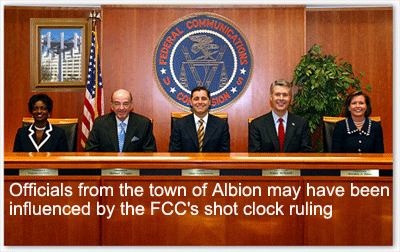 the first FCC shot clock cases to be filed after a carrier and a Maine community explore signing a consent agreement. the first FCC shot clock cases to be filed after a carrier and a Maine community explore signing a consent agreement.
U.S. Cellular filed a complaint on November 8 in U.S. District Court in Maine, claiming the Albion Planning Board violated the federal Communication Act of 1934 by not acting "within a reasonable time" on their proposal to build a 190-foot tower.
As defined by the FCC's shot clock ruling of November 18, 2009, a town must act within a 150-day window.
U.S. Cellular also claimed that Albion denied their application without written decisions “supported by substantial evidence contained in a written record”.
Citing that the cost of fighting the carrier in federal court would be prohibitive, Albion's three-member Board of Selectmen voted unanimously during a special meeting Monday night to pursue a consent agreement with U.S. Cellular.
Although the inherent legal fees to represent the town was a major concern, as expressed by Second Selectman Marion Foster, it is not known whether the town's officials were concerned that their decision violated the FCC's 150-day time frame to make a decision upon the proposed tower at the edge of a hayfield on Belfast Road.
Richard Trafton, an attorney representing U.S. Cellular, said on Tuesday that U.S. Cellular "is actively working with Albion's Board of Selectmen to fashion an agreement which will permit construction of the proposed telecommunications facility."
A key concern that surfaced during numerous planning board and public hearings was whether U.S. Cellular needed to build its own tower in order to fill its coverage gap, or whether the company could achieve that by co-locating on either of the two existing cell towers in Albion, owned by Stargate.
Albion's zoning ordinance states that co-location is the preferred method.
However, U.S. Cellular submitted an RF study that identified that construction of the new tower was needed.
Their competitor, Stargate, provided a study that disagreed with U.S. Cellular's report. Planning board members said they needed an independent, third party to submit an RF study that the board could rely on. Citing a town ordinance, they asked that U.S. Cellular pay for an independent study by setting up an escrow account with $5,000 to pay for it.
On July 12, the Planning Board unanimously voted to reject the application, citing U.S. Cellular's "refusal to fund the services of an outside consultant." The application then went to Albion's Board of Appeals, which denied the company's appeal of the decision.
Black Diamond Consultants, of Gardiner, represented U.S. Cellular in the application process.
-
|
|
Court vacates ruling against towerco stating
competitor's site could cause cancer
November 12, 2010 - The New Hampshire Supreme Court on Wednesday reversed a $6.7 million verdict against a wireless communications provider, saying its advertising campaign against a  competitor was protected as free speech. competitor was protected as free speech.
Fifth Estate Tower waged the postcard and advertising campaign to defeat a bid by Green Mountain Realty Corporation to install communications towers in Wolfeboro. Wolfeboro voters defeated the proposal in a special town meeting in 2005.
The cards allegedly urged town voters to vote against the two warrant articles because the town did not need "to get better cellular service or emergency services" as it "already (had) existing structures to handle both."
The cards referred to the proposed communications tower as an "eyesore" and unnecessary.
In the months preceding the special town meeting, in addition to sending the postcards, Fifth Estate also ran a series of advertisements, newspaper pieces, radio announcements and mass mailings that included statements that the tower to be erected on Poor Farm Hill would destroy the town's picturesque skyline; for the water tank site alone, Green Mountain would take more than $1 million from town taxpayers; Green Mountain's personal wireless service facilities would cause residents to suffer from cancer, Alzheimer's disease and other serious illnesses; and that the leases would cost taxpayers between $200,000 and $600,000 over their respective terms.
Green Mountain sued, eventually winning the jury verdict against Fifth Estate.
In its unanimous ruling, the Supreme Court ruled that Fifth Estate's campaign was political speech and exempt from the state Consumer Protection Act. It rejected Green Mountain's argument that the campaign contained false claims and, therefore, violated the act.
The justices noted that even if Fifth Estate's campaign involved unfair or deceptive practices, the act does not apply because Fifth Estate's conduct occurred in a political setting. Its campaign against Green Mountain Realty, the court wrote, used public media "for the purpose of influencing political decisions of the general electorate."
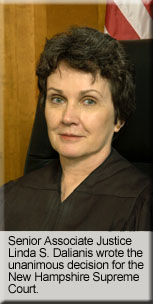 "The CPA, like the Federal Trade Commission Act, is tailored for the business arena, not the political arena," wrote Senior Associate Justice Linda S. Dalianis, who authored the opinion for the Court "The CPA, like the Federal Trade Commission Act, is tailored for the business arena, not the political arena," wrote Senior Associate Justice Linda S. Dalianis, who authored the opinion for the Court
"We assume, without deciding, that Fifth Estate’s conduct constituted an unfair or deceptive practice, within the meaning of the [Consumer Protection Act]," the court wrote. "Nonetheless, we conclude that the [act] does not apply because Fifth Estate’s conduct occurred in a political setting."
The Court also concluded that Fifth Estate's "mere attempts to influence" the passage of the warrant articles does not violate the act, even if, as Green Mountain alleges, Fifth Estate's sole motive was to eliminate Green Mountain as a competitor.
Also, the Court was not persuaded by Green Mountain's assertion that the special town meeting at issue didn't involve the passage or enforcement of laws.
"As Green Mountain acknowledges, the town of Wolfeboro has a town meeting form of government, and "it is well understood that, within the limits of the power of legislation conferred upon it, a town meeting is a legislative body," Dalianis wrote for the court.
At the lower level, the court had instructed jurors that Fifth Tower's claims were commercial in nature and not protected by the First Amendment. Each of the 3,337 postcards mailed by Fifth Tower were counted as individual violations in arriving at the award.
During the election, Fifth Estate prepared and mailed the community's registered voters a postcard purportedly depicting one of the proposed towers, to illustrate its concern that the tower would be an eyesore.
At trial, Green Mountain’s expert testified that the image of the proposed tower was approximately twice the size of an accurate rendering.
To read the full ruling, click here.
-
|
|
Residents say two roof top BTS units could collapse their building
August 31, 2010 - Residents of a Washington Heights, N.Y. apartment building say that they're worried that their building is going to collapse due to the weight of two base stations situated on the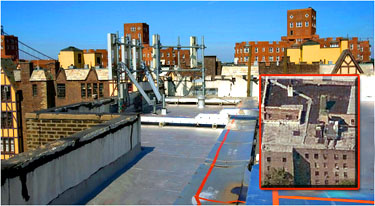 top of the roof on their 82-year-old building. top of the roof on their 82-year-old building.
The six-story brick building sits upon a hilltop at 165 Pinehurst Ave. and has approximately 20 antennas positioned on the roof to accommodate an AT&T and T-Mobile cell site.
Cracks have appeared along the building’s outer walls, and mortar has crumbled from the parapet, which supports I-beams that the base stations sit upon, according to the building's occupants.
The tenants are suing their landlord for allowing the cell sites to be installed, however they have not identified if they have any engineering reports to qualify their concerns that the base stations are causing the structural harm.
The Buildings Department approved the landlord’s application to erect the most recent base station for AT&T last summer, after determining, a spokeswoman said, that the plans complied with the building code.
Steve Kazella, a managing partner of AirWave Management, a company in Chester, N.J., that consults for landlords negotiating with wireless carriers or their cell-site partners, told the New York Times recently that buildings typically faced a bigger threat from the weight of their air-conditioning units, and yet people tended not to complain about those units.
Representatives from T-Mobile and AT&T said they were exacting in installing such equipment safely, with the approval of structural engineers and in accordance with building codes.
|
|
Premier wireless consulting firm flubs in its recommendations says court
July 29, 2010 - "We are the premier municipal wireless consulting firm in the country. We have over 1,000 clients in 30 states and our regulations for municipalities have never been challenged in court,"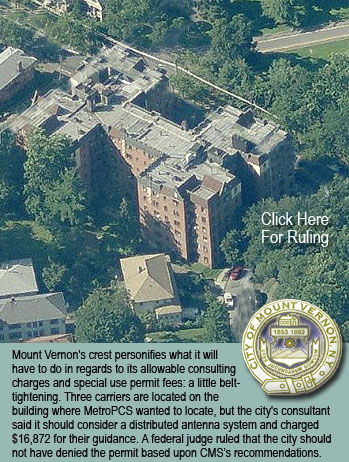 said Richard Comi of the Center for Municipal Solutions (CMS), a municipal telecommunication consultant company, to Oradell, N.J. Borough Council members on July 13. said Richard Comi of the Center for Municipal Solutions (CMS), a municipal telecommunication consultant company, to Oradell, N.J. Borough Council members on July 13.
That may be true, but one of Comi's clients across the Hudson River, Mount Vernon, N.Y., used his recommendations to deny a carrier a special use permit and a federal court on July 22 ruled that the city discriminated against MetroPCS by requiring it to use an alternative technology even though that preference went against their zoning code’s explicit prioritization of collocated facilities.
MetroPCS chose the East 3rd Street building in part because it qualified as the highest priority site in the community pursuant to the city's zoning code.
It also modeled its proposed stealth rooftop wireless facility on the facilities that had already been approved for the three other carriers: Nextel, T-Mobile, and AT&T.
The city wanted it to use Metro's DAS.
The court also found that CMS's actions delayed the application by "repeatedly requesting unnecessary information and belaboring issues already resolved" and it resulted in an unreasonable delay on final action on the application in violation of the Telecommunications Act of 1996.
In addition, U.S. District Court Judge Stephen C. Robinson found that the Mount Vernon's zoning ordinance allowed it, through CMS, "to charge a wireless carrier prohibitive fees by simply dragging out the process and utilizing consultants for its convenience—rather than out of necessity."
|
Circuit Court upholds illegality of
DAS-type ordinance
MetroPCS and Comi exchanged letters and engaged in conference calls in 2009 to discuss the issue of whether a feasibility study of expanding the DAS network should be required as part of the application, or even if it was legal.
MetroPCS said the Planning Board should not insist on an alternative technology given the decision in New York SMSA Ltd. Partnership v. Town of Clarkstown.
In that district court case the court held that legislation codifying a preference for alternate technologies over other FCC authorized technologies was preempted because federal law occupies the field when it comes to technical and operational aspects of wireless service.
Clarkstown appealed the decision, but the Second Circuit ruled on June 30, 2010 that a local zoning ordinance cannot dictate the type of antenna model and design that should be utilized or the technology deployed within its jurisdiction.
Click here for the Clarkstown court ruling.
|
Comi’s firm's billing through July 2009 totaled $16,842.70. Mount Vernon noted that MetroPCS would also be responsible for fees from July 2009 going forward which had not yet been invoiced.
Judge Robinson also said that there was no evidence "that the fee for a telecommunications facility should be twelve to twenty-four times higher" than fees for other special use permits.
MetroPCS claimed that there is no justification for charging $6,000 to $12,000 for a special permit application for a wireless telecommunications facility, in contrast to just $500 for all other special use permits which cover such major projects as universities, drive-thru fast food restaurants, manufacturing facilities, car dealerships amongst other businesses.
Mount Vernon made the argument that because the TCA requires that applications for wireless
telecommunications facilities be handled without unreasonable delay, that it justifies the higher cost.
Judge Robinson disagreed, stating, "Ironically, the extraordinary costs incurred in this case were largely due to unreasonable delays as the city discriminated against MetroPCS and denied its
application without substantial evidence."
A subsequent order will determine the amount of fees that the city must repay to MetroPCS.
Click here for the Mount Vernon court's ruling.
|
Firefighters' advocate wants 1996 Telecommunications Act repealed
because of First Amendment violation
July 16, 2010 - An advocate for the health and safety of firefighters, who failed to get a national moratorium on the placement of cell towers on fire station property, is now trying to get the 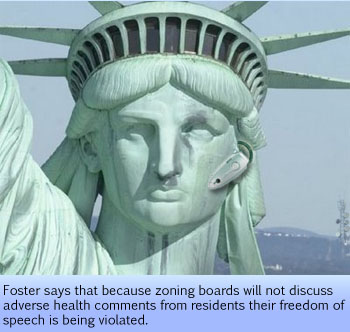 1996 Telecommunications Act Sec. 704 repealed. 1996 Telecommunications Act Sec. 704 repealed.
Rancho Santa Fe, Calif. resident Susan Foster says that the act violates freedom of speech because at siting hearings she says the public is forbidden to complain about health effects relating to cell tower radiation.
With respect to cell tower siting, local governments can only consider the potential health effects of radiofrequency emissions within the limits of the Communications Act.
The Act provides that no local government may regulate siting based on the effects of radiofrequency emissions if the facility complies with the FCC's regulations on the issue.
Accordingly, local governments that deny a siting request based on health concerns beyond the FCC's regulations will find their decisions overturned by the courts.
Therefore, in most municipalities officials will not allow the public to discuss the contentious subject at their hearings.
A local government can respond to community concerns without putting its zoning decisions at risk. Local governments can both urge Congress to grant it further authority in this area, and call upon the FCC and other agencies to revisit regulations with respect to cell tower radiation.
Foster, however, doesn't agree and wants residents to start a movement, based upon a First Amendment violation, to petition on a federal level to have the Act repealed.
In 2004 she was honored as "Firefighter for Life" by the San Diego Fire Department for her efforts in assisting the International Association of Firefighters to introduce Resolution 15, which called for a moratorium on the placement of cell towers on fire stations.
Foster believes that the reason President Clinton signed the Act was because the wireless industry gave candidates "hundreds of millions of dollars."
The medical social worker said that radiation from towers is a serious problem and information is being concealed by the telecommunications industry.
“If this were benign, why has a wireless executive living in Rancho Santa Fe sheathed his entire house in copper? Copper and lead are the only two metals through which RF radiation does not penetrate,” she told The Coast News. |
|
Court gives a cold shoulder to a brittle steel concern about an SBA tower
May 28, 2010 - In a recent ruling issued by the Indiana Court of Appeals, a tower developer was given approval for the second time to construct a new communications tower in Porter County, Ind.
Court records indicate that the evidence brought before them by attorneys for the Porter County Board of Zoning Appeals was devoid of any probative value and the BZA's findings and determination for denying SBA Towers' grant of a Special Exception were  clearly erroneous. clearly erroneous.
In their objection to the 199-foot tower near Pines Peak Family Ski Area, as detailed in the ruling, the BZA asked the court to consider the safety of skiers.
"Steel, when it gets extremely cold, is subject to high loads like strong winds, like this tower would be exposed to would crack like glass when it gets cold. It's called brittle fracture."
The appellant said that as long as the design and the construction of steel are specified there should be very little possibility of catastrophic failure, "but, as we know from the bridge at Minneapolis and the levees in New Orleans and, most famously, the unsinkable Titanic, mistakes are made. If this tower does incur catastrophic failure, it most likely will be in the winter when the ski hill is active."
They did not document any tower collapses in the nation's portfolio of hundreds of thousands of towers that were caused by low temperatures.
"If BP's offshore well had ruptured prior to this appeal, I'm sure that would have been thrown into the red herring mix of reasons to deny the tower," said a design engineer who frequently provides testimony at hearings regarding fall factor studies and other structural engineering information.
SBA had responded to the BZA's concerns by stating that their towers are built to industry standards and also noted that a lot of times during the hurricanes that happened in the South that the only structures standing were towers.
They also pointed out that they would have to meet all codes and standards and would have to go through the building permit process to ensure they met all of the standards.
The Court of Appeals gave a cold shoulder to the brittle steel fracture argument and presumably believed that the processes in place for ensuring that there would not be a tower collapse would be prevented by proper design and review by the county's building department. The same professionals that reviewed the ski lodge's plans to guarantee that residents would not be thrown like rag dolls off of collapsing steel ski lifts.
SBA had applied for the variance in 2008 for the five-carrier monopole, but was turned down when the board ruled that it would interfere with the beauty of the local area and that it could possibly have unknown health concerns.
SBA filed a lawsuit against the county, however, and won. The county appealed, but in this decision the Court of Appeals ruled in SBA's favor.
The court said that the federal Telecommunications Act had found no health concerns in dealing with cell phone towers and did not allow it to be part of reaching a decision in placement of cell towers.
The court ruling is available here.
|
|
Judge rules height is important, but girth isn't a concern
May 13, 2010 - In a state that consistently comes in every year with the lowest percentage of obese adults, it was surprising to hear a Colorado judge last week rule that it's okay to carry a couple of extra feet around your mid section. That is, if you're a 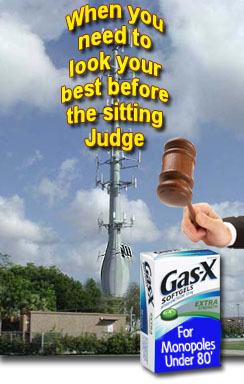 tower. tower.
Judge J. Steven Patrick, at District Court last Thursday, denied a temporary restraining order on an Ouray County building permit for a tower that the plaintiffs, Log Hill Village subdivision property owners, claimed was substantially wider than the original drawings and those filed with the building permit.
County Attorney Mary Deganhart said the judge focused on the visual impact of the tower’s height, 80 feet, not the possibility of two feet more in width at the base.
“Judge Patrick confirmed that you did not commit any errors in any step in the process,” said Deganhart.
The BOCC had approved a special use permit for the tower in late April 2009. By citing health, safety and welfare concerns, the BOCC agreed the proposed 80-foot tower would standardize and improve emergency response and intercommunication.
The tower and equipment shelter will be built on Dallas Creek Water Company property that currently contains two water tanks and three smaller communications towers. According to the permit application, Verizon Communications would enter into a lease with Dallas Creek and erect cellular phone antennas and receivers for commercial use.
|
|
Connecticut Siting Council is being reined in by legislators
April 29, 2010 - The Connecticut House of Representatives unanimously approved a bill which would put new restrictions on the Connecticut Siting Council's ability to approve new cell tower locations.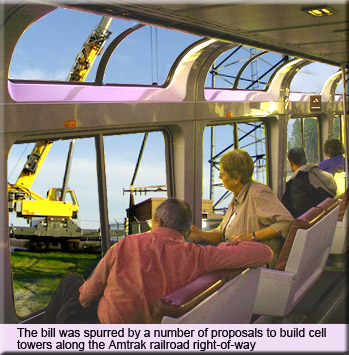
The bill, which the House approved Tuesday night, also would penalize telecommunications companies that submit deceptive applications, said state Rep. Lonnie Reed, who introduced the bill along with state Reps. Pat Widlitz and Deb Heinrich.
"A unanimous, bipartisan vote sends a powerful wakeup call to the Connecticut Siting Council that has been approving more than 90 percent of the applications for cell towers," said Reed.
The bill was spurred by a number of proposals to build cell towers along the Amtrak railroad right-of-way, several of which would be in scenic or residential areas.
"We must ensure a fair process and give much more consideration to new technologies that minimize impacts to neighborhoods, the environment and to scenic treasures such as Long Island Sound," Reed said.
She also said that "penalties must be imposed on those who would game the system."
"Around the state, cell tower construction is ramping up and we are seeing more and more of them being approved by the Siting Council in residential areas," said Heinrich.
"I believe that the Siting Council may have lost its way. This bill represents a responsible and effective response to a problem that only grows bigger as time goes on." Widlitz told the New Haven Register.
"The passage of this bill is critical," she said. "We are being bombarded with cell tower proposals along the Shoreline. This is an assault on our towns, degrading some of the most valuable, ecologically sensitive and scenic property in the state. There has got to be a better way."
The bill requires the Siting Council to consider alternative technologies instead of cell towers before approving an application. It also gives the Siting Council the power to punish telecommunications companies that submit deceptive applications and to give that money to opponents to pay legal fees.
It also requires the CSC to consider public health and safety issues and to give priority to regional plans suggested by towns.
The bill also bans the placement of towers within 750 feet of schools or day care centers unless no other safe site is available.
|
|
Judge in sync with New Jersey zoning board's monopole denial
March 28, 2010 - In a March 19 letter of opinion, New Jersey Superior Court Judge Douglas Fasciale upheld a 2008 decision by the Cranford, N.J. Zoning Board of Adjustment which rejected a 120-foot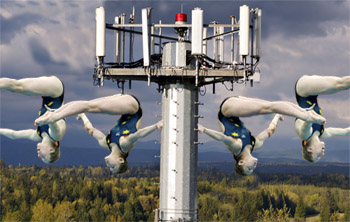 cell tower at the Cranford Swimming Club. cell tower at the Cranford Swimming Club.
The Zoning Board of Adjustment rejected an application in 2008 by Verizon Wireless, AT&T, and Omnipoint, a branch of T-Mobile, as a cooperative to build a 120-foot monopole tower on the grounds of the club near the Cranford-Westfield border.
The carriers proposed building the tower on the only non-residential property in the area in a segment of the property less than 20 feet from the shared property line with homes in Westfield.
The application, which was heard in a series of 10 meetings that stretched for 14 months, was ultimately rejected when the board unanimously found that the cellular providers had failed to prove a significant gap in coverage.
While the cellular carriers claimed that the tower was essential to providing coverage for the area, residents from both Cranford and Westfield joined together in listing their objections, saying that the tower would irreparably damage their property values and way of life.
Objections to the tower were also raised by representatives of Union County, claiming that the tower would have a lasting negative impact on Lenape Park.
|
|
Two pilots die after plane crashes into an illegal cell phone tower
March 9, 2010 - Indian authorities said today that the cell phone tower atop a three story building that a Navy plane crashed into last Wednesday was constructed illegally.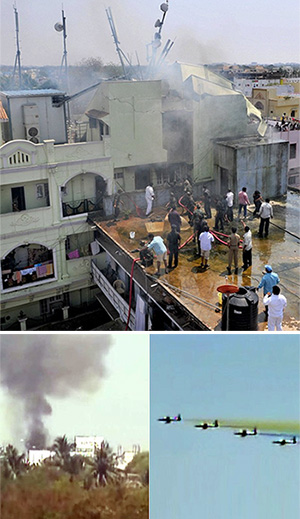
The Kiran MK-II plane, which was part of the Sagar Pawan aerobatic team participating in a display at the India Aviation show 2010, crashed into the building at New Bowenpally, killing its two pilots and another man on the ground.
Four residents were also injured. A woman and her 20-year-old son jumped from a window and fractured their legs and arms.
The three-member committee, set up by the Secunderabad Cantonment Board, found that the penthouse and structure for the cell phone tower were constructed in violation of height requirements that limit buildings in the area to two floors.
Authorities could not immediately identify the carrier or owner of the cell phone tower.
However, a day after the Navy aircraft crashed into the apartment, the owner of the house said he wants compensation for the damage caused in the accident.
He said that the responsibility for obtaining proper permission to install the structure on his penthouse should have been borne by the cell phone company.
A view of the surrounding area shows numerous buildings in violation of height restrictions, many of them also leasing their penthouses to carriers.
India is known for having thousands of cell towers that have been constructed illegally.
The Municipal Corporation of Delhi reported late last year that 56% of the city's towers were illegal.
Under a request under India's right to information request, an initial review indicated that only 2,015 of the 4,532 cellular towers in Delhi, with a population of over nine million, are legal.
American Tower Corporation announced last month that it was going to purchase Essar Telecom in India. Essar currently owns and operates about 4,450 wireless communications sites, including a number of sites that are under construction, American Tower said, while announcing its financial results for the fourth quarter and full year 2009.
The deal was valued at $430 million. American Tower already has about 2,500 towers in India from two acquisitions last year.
.
|
 |
|
Got zoning for that tower? You can bet your base section on it!
February 2, 2010 - Just when you were converted to believe that all new scams were birthed in sunny South Florida, India's police say they have uncovered a tower leasing program that seems like it  was hatched in Bollywood. was hatched in Bollywood.
Six con artists were arrested last month for allegedly floating a fake tower site acquisition company that canvassed small villages and fleeced residents after telling them that they were in the process of installing communications towers for a private company.
They were told that they could benefit from the no longer American, but Indian dream of sharing in the benefits from a steel cash cow.
The racket's head confidence man, only identified as Saroj, would come to town with his entourage of shills that posed as engineers, surveyors and tower technicians.
They would then select prime real estate for their towers and offer huge sums of money to the villagers if they could build a structure upon their land.
If there was any reservation from the landowner, the ever-popular, If you won't, someone down the road will, won the hearts, minds and money of a number of people from Janipur and Beur in the Patna district.
However, the tower company, identified as Phulwari, required good faith money to begin construction and collected $1,000 or more from villagers. Others who wanted to be a part of the galvanic steel rush sold their prized possessions including motorcycles.
On occasion, a number of potential investors were hesitant to depart with their rupees and asked for additional assurances that they would be taking part in a safe investment.
To win their confidence, the con men would drop off some tower steel at the site that had little value when the villagers tried to recover their money after contacting authorities.
After raiding the homes of the six accused men, police found several fake seals, letterheads and other documents that implied that they were in touch with other people anxious to lease space on their property.
|
|
If your lawsuit has questionable merit, just throw out the erase card
January 15, 2010 - A Bayville, N.Y. couple filed a lawsuit on Monday, asserting that by allowing antennas on a water tower near their home their township reduced the value of their home between 3 to 5 percent.
That may be hard to prove for Thomas and Elke Hoy's attorney, Andrew Campenelli, who will have to provide comparables of homes that were sold around the water tower before and after antennas were added and provide a sampling that is statistically accurate.
The suit states that Bayville violated the agreement on which the land was donated to the village in the 1950s, which provided that the land could not be used for any commercial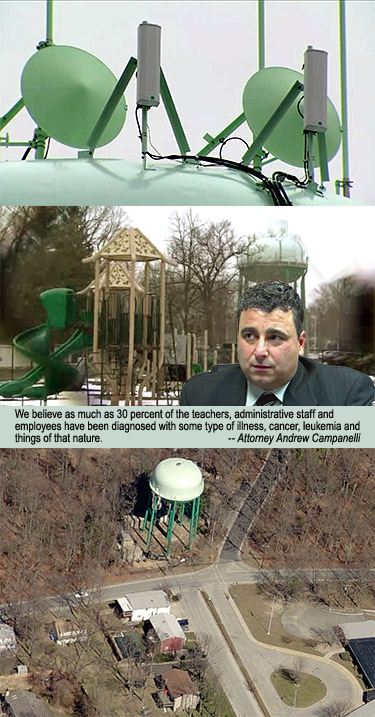 purpose, according to Campanelli. purpose, according to Campanelli.
The deed does not allow "commercial enterprises" or "anything that is offensive, dangerous or obnoxious."
The bulk of the antennas have been atop the water tower since 1993.
Campanelli said the village is not enforcing the provisions of the federal Telecommunications Act of 1996, which allows communities to consider restrictive land-use agreements in order to block the installation of cell-phone antennas.
However, village attorney Anthony Sabino said the installation of the antennas does not violate the agreement or federal law.
Wireless carriers pay the village more than $200,000 a year to mount the antennas.
According to Newsday, the Hoys' suit states that the rate of cancer among students and teaching personnel at Bayville Elementary School adjoining the tower is much higher than normal, resulting in illness among 30 percent of school's staff.
The American Cancer Society has said there is no known link between cell towers and an increased cancer risk in humans. Other studies and health organizations concede that there is no worthwhile evidence to link even cell phones, which create more RF radiation than the antennas on the cell towers.
Campanelli said he had no direct scientific proof to support the relationship between alleged cancer rates and radiation from the cell-phone antennas, saying, "I'm not a scientist, just a lawyer."
However, Campanelli is aware of the ACS's statement and wants to erase any other supporting evidence that doesn't echo his client's beliefs.
In a pre-filing interview with WPIX, Campanelli again exploited his client's cancer scare tactics by stating, "We believe as much as 30 percent of the teachers, administrative staff and employees have been diagnosed with some type of illness, cancer, leukemia and things of that nature."
Anna Hunderfund, superintendent of the Locust Valley School District, which includes Bayville, said in a written statement that a consulting firm hired by the district "concluded that the cell phone tower posed no significant health risks to students or staff . . . there is no truth to any claims that 30 percent of our students or staff have become ill as a result of the location of the cell phone tower."
|
|
Franklin County Mo. makes it to the top of the zoning dunce list
January 1, 2010
Earlier this year, Lake Elmo, Minnesota's mayor said that a T-Mobile tower looked like a junkyard on a stick. Such nerve! And then a northeast building official had the unmitigated gall to accuse an applicant of wanting to porcupine America. Whoa! Have they no conscience or sense of civility?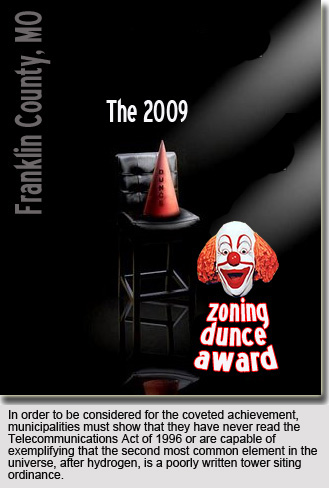
Of course, as insidious as these siting sacrileges are, they are protected by the First Amendment to the United States Constitution.
Deciding to place an onerous tower siting requirement on an applicant is not.
In reality, wireless carriers have certain inalienable rights as provided for by the 104th Congress when they approved the Telecommunications Act of 1996.
But Franklin County Missouri's officials believe they are beyond those petty guidelines and that's why they have been selected to receive the First Annual WirelessEstimator.com Zoning Dunce Award.
As part of a new telecommunications ordinance effective this past September, their requirement says: "Prior to approval of any application for a new tower, the tower owner shall submit a signed and notarized document guaranteeing that they will allow local public service providers to use the tower at no charge. "
Good heavens! That would mean that the tower company would have to design the structure to provide capacity for the fire and police departments' antennas. Let's not forget that the department of public works is a local service provider as well as the gas utility, electric company and, of course, all of the public service bus and taxi companies.
And if PBS, designated by the FCC as a public service media company, wants to ensure that every resident laughs along with Click and Clack on Car Talk, rather than Franklin County's planners, we're now up to a 500-foot 144-inch diameter solid-rod monopole with a foundation that would be required to tunnel northeast and curlicue around the St. Louis Gateway Arch for stability.
Although there will be no requirement for portholes, they'll need to enlarge its girth even more if a Missouri airline or trucking company wishes to demand a co-location on the structure.
Here's how they secured the award
In reverence to the late Billy Mays, we're not going to shout out, "But there's more!" But there is.
Franklin County Emergency Management Agency Director Bob Dopp was instrumental in securing this year's dunce award for Franklin County by recently unveiling his plan to reduce the number of cell towers in the area and increase communication abilities between law enforcement and rescue agencies.
Dopp spoke to the Planning and Zoning Commission this month, showing his support to replace several towers around the county with ten 500-foot towers.
The commission took a step toward Dopp's hope, unanimously approving a conditional use permit allowing RCC, Inc. Radio Comm Co. to replace an existing 360-foot tower located in the community development zoning district with a new 500-foot guyed tower.
He said he's spoken to telecommunication tower companies who operate in Franklin County and four or five are open to the change, which would eliminate all other towers in the county.
Blake Bowers of Frosty Towers questioned Dopp's exhaustive research. "I find it interesting being a tower owner operating in Franklin County, just down the road from the first of the 500-foot towers, that I was never contacted by Mr. Dopp for my input on his plan."
Bower's tower, a mile and one-half away, is the closest structure to Franklin County's newly permitted guyed tower.
If the county were to build the towers on their own, it would come at a cost of $26.5 million plus $800,000 per year for maintenance, Dopp said, according to the Missourian.
Thankfully, Dopp is not advising capital markets or design engineers about attenuation and capacity.
|
|
Consultant's fee will be $3,500 for analysis of a one-square-foot antenna
December 21, 2009
When RidgeviewTel put equipment upon the Hadlock farm in Hammond, Colo. last year it was to service a handful of ISP customers. to service a handful of ISP customers.
Now the town is saying that company didn't comply with its local law that says that it has to hire a communications consultant to review the firm's plans at a cost of about $3,500.
The antenna, attached to a silo measures approximately six inches by two feet.
According to a representative of RidgeviewTel, the company has similar situations at 16 different privately-owned silos, all over Jefferson and Lewis counties, and they're not running into such problems. He said all they've needed for other municipalities is a building permit to build on private structures.
RidgeviewTel addressed the town board to request that the fees be waived, to no avail.
|
|
Agency scraps idea for tower on Cadillac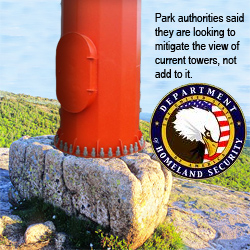 Mountain Mountain
December 20, 2009
A federal agency has scrapped the idea of placing an 80-foot telecommunications tower atop the tallest mountain in Acadia National Park in Maine.
Cadillac Mountain was one of about 60 sites in the state that the U.S. Customs and Border Protection agency was considering for towers to enhance federal homeland security communications.
Park officials said that they recently received a letter from the agency saying it had removed Cadillac Mountain from consideration because of opposition from the National Park Service and the local community.
Cadillac Mountain is the only peak accessible by public road in the park, which gets more than 2 million visitors a year.
|
|
Carrier's 100-foot cross completed 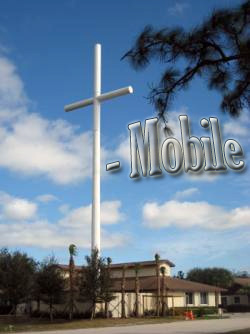
in time for Christmas
December 18, 2009
The gleaming white towering cross, at the Epiphany Lutheran Church in Lake Worth, Fla., can be seen from several miles away.
The T-Mobile cell site is over 100 feet high, thirty feet across and nine feet at the base.
Said Pastor Dr. Douglas E. Fountain, "We're happy now to spread the Good News as we start to celebrate Christmas."
Executive Director, John Sasson said, "We could never afford this kind of advertising."
T-Mobile approached the church in the spring of 2008, proposing to build a tower to supply cell coverage to the neighboring community.
|
|
Flagpoles are stretched 33 feet higher, but city fathers can't shorten them
November 2, 2009
Lawrence, Kans. - Tower development contractors who have been taken to the cleaners because they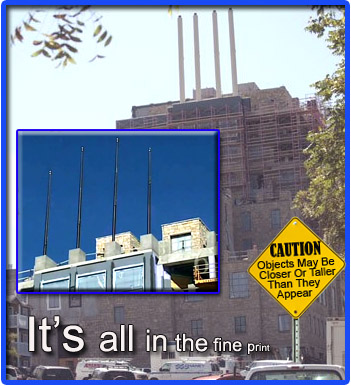 didn't carefully read plans and documents have discovered that construction drawings are usually secondary considerations when an opposing requirement or detail is provided elsewhere in the bid package in writing. didn't carefully read plans and documents have discovered that construction drawings are usually secondary considerations when an opposing requirement or detail is provided elsewhere in the bid package in writing.
And sometimes it's to the contractor and developer's advantage.
As the Oread Hotel nears completion, four 50-foot cellular telephone towers atop the building are generating attention as well as questions as to whether the cell sites on the structure were properly presented to city commissioners for approval.
The city's planning director, Scott McCullough, said that official drawings submitted to the city showed the flagpole towers being 33 feet shorter than what they actually are.
“We probably should have asked for a better depiction of what the maximum structure could look like with the flagpoles,” McCullough told the Lawrence Journal World.
But McCullough said the towers are legal. That’s because in addition to the drawings, the developers submitted several notes that were attached to the final development plan. One of the notes — one of about 55 presented in footnote form — said the towers ultimately could increase the total height of the building to 156 feet.
McCullough said the written notes take precedence over the drawings.
|
|
Developer to take down size and price of homes,
and a tower without an owner
September 16, 2009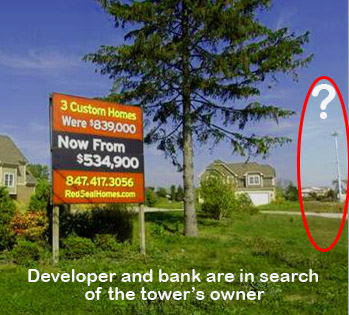
Buffalo Gove Village, Il. - Red Seal Development Corp. has entered into an agreement with Parkway Bank and Trust Co., which now owns the subdivision of Villas of Chestnut Ridge, to complete the project, although because of the market, plans have been scaled down.
The village board agreed to allow the architectural changes as well as agreeing to relax the deadline for Parkway to pull down an unused cell tower.
A Parkway representative said no one previously associated with the tower is stepping forward to remove it.
"I'm not certain who to even speak to about removing it, except for calling some guys that I know to come over with saws and a torch," Eugene Kraus said.
The board will allow Parkway to explore its options, setting a deadline of April or whenever the first occupancy permit on one of the 18 homes is issued for the tower to come down.
|
|
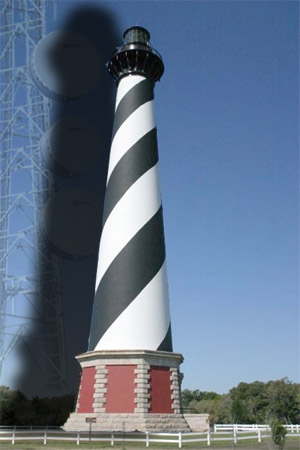
Coast Guard tower requested to be
built in the shadow of the
Cape Hatteras Lighthouse
September 10, 2009
Buxton, N.C. - A proposed radio tower that would go up in the shadow of the Cape Hatteras Lighthouse has raised concerns among historic preservationists, who feel it would be a blight on the view around the landmark.
The Virginian-Pilot of Norfolk reports that the U.S. Coast Guard wants to build the 525-foot tower, which would be part of an upgrade of its search-and-rescue communications system.
Such a system, considered a marine version of 911, is already in place in Hampton Roads and the Eastern Shore in Virg., and in N.C.
Renee Gledhill-Earley, of the State Historic Preservation Office, said photographic simulations with the draft environmental assessment don't support the Coast Guard's argument that the tower won't be visually obtrusive.
She said the tower should be built elsewhere.
|
|
Residents say profit is motivation behind railroading through a 200-foot tower
September 8, 2009
Jupiter, Fla. - The Florida East Coast Railway wants to build a communications tower twice the height of the historic Jupiter Lighthouse, and residents on the north side of the Loxahatchee River are concerned about spoiling the coastal skyline.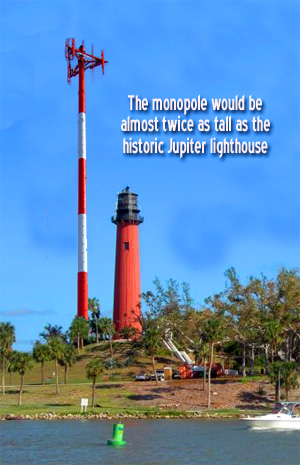
The monopole is needed to upgrade railroad communications and improve railroad safety.
The FEC wants to begin construction early next year, said Richard Newton, president of Atlanta-based Signal Port LLC, the company proposing the tower.
The proposed 200-foot tower is in a "totally inappropriate location" and should be moved, said Mayor Karen Golonka. Town officials have met with Signal Port officials and plan more discussions, she said.
The FEC is not required to comply with the town's 50-foot communication tower height requirement. Nor must the FEC obtain approval from the Jupiter Town Commission to build the tower, said town attorney Tom Baird.
The 1995 Federal Interstate Commerce Commission Termination Act prevents "a patchwork of local regulations" from interfering with railroad operations, said Newton.
After meeting with Jupiter officials, FEC officials are considering a site on the south side of the CSR Rinker Materials property, east of the FEC railroad tracks between Tequesta Drive and the Jupiter/Tequesta border.
Once the tower is built, the FEC said it plans to offer the structure to other wireless companies for co-location purposes.
Some residents believe that profit is the primary reason why FEC wants to build the tower, not a need for railroad operations. They noted that it will be almost twice as high as the the community's historic lighthouse.
|
|
Tower owner to play the flag card to replace his eyesore
September 7, 2009
Sag Harbor, N.Y. - The 225-foot tower near Middle Line Highway is an eyesore, or so says Myron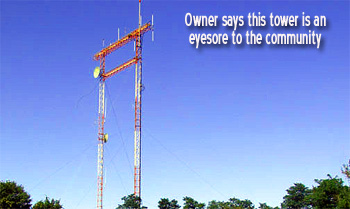 Levine, who owns the tower and the property that it is built upon. Levine, who owns the tower and the property that it is built upon.
However, he hopes to present a plan to the Southampton Town Planning Board in the next two to three months to dismantle the existing tower and build a smaller one designed as a flagpole.
The tower was built in the 1950s for radio and television transmissions. Currently, Verizon leases use of the tower, but this agreement expires in December of 2011.
Verizon is looking to build a 120-foot tower and relocate it to the western side of Levine's property.
Levine says the property is already zoned for a tower which should expedite the review process.
When Levine attempted to rent out his home for two weeks, the prospective renters were initially interested in the property. After they drove up to the home and saw the tower, their interest waned very quickly.
"Everybody complains about that tower," Levine told The Sag Harbor Express. "I think this would have tremendous support from the public."
The old head end structure was bought by Levine from Cablevision earlier this year. In addition to Verizon, a number of two-way companies lease space on the tower.
There are a number of multi-million-dollar homes in the surrounding area.
|
|
Cell tower rejection can be permissible on aesthetic grounds, court rules
August 25, 2009
PLATTE COUNTY, MO - The 8th U.S. Circuit Court of Appeals has ruled that a tower proposal can be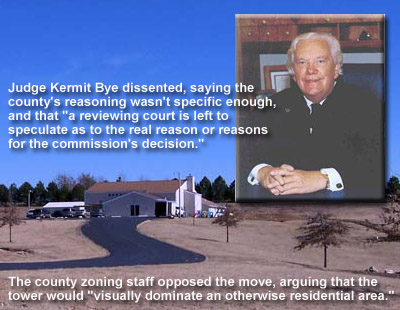 denied based upon aesthetic concerns. denied based upon aesthetic concerns.
In a 2-1 decision, the appeals court affirmed Platte County's denial of a permit for a 153-foot tower that Sprint PCS sought.
The Telecommunications Act of 1996 requires local governments to provide written reasons for denying telecommunications towers. Judge Steven Colloton, joined by Judge Raymond Gruender, said a four-paragraph explanation from the Platte County Commission was "adequate to the task." The paragraphs essentially mirrored the county zoning code.
The Platte County Commission objected to the proposed tower because its size, location, and relationship to surrounding screening and landscaping were such that the tower would “dominate the immediate neighborhood so as to prevent development and use of neighboring property.”
However, Judge Kermit Bye dissented, saying the county's reasoning wasn't specific enough, and that "a reviewing court is left to speculate as to the real reason or reasons for the commission's decision."
Sprint wanted to place the tower on a 7.5-acre parcel of land owned by Our Savior Lutheran Church. The land was zoned for agriculture. The county zoning staff opposed the move, arguing that the tower would "visually dominate an otherwise residential area." Neighbors feared it would affect their property values.
The case marked the first time the 8th Circuit has addressed what satisfies the "in writing" requirement of the Telecommunications Act. Several other circuits have said the written denial needs to give a sufficient explanation of the reason for the rejection.
However, the 4th Circuit found that a "denied" stamp on a form met the requirements of the law.
|
|
Carrier begs forgiveness after not asking for permission to exceed height limitations
August 24, 2009
CASPER, WY - Family owned and run Union Telephone ran afoul of Natrona County Commissioners when it was found that that they had falsified permit information for 11 towers that they had erected. information for 11 towers that they had erected.
The mobile carrier operates more than 120 towers to service their market and in an effort to expand coverage as quickly as possible, they filled out incorrect height information for the towers, including one that was a mile from its proposed location.
The structures were all listed as being less than 45 feet, the maximum height before a special use permit is required. However, they exceeded the county height requirements.
The falsifications became known in June (See June 19 article below) after a property owner near Alcova sent a commissioner a photo showing an approximately 80-foot-tall tower erected on a ridge close to his home.
Union Telephone reportedly had applied for a building permit for power on the site, but did not have a conditional-use permit from the county to erect a tower taller than 45 feet.
A representative from Union Telephone said they would agree to file and pay double for conditional-use permit applications for a number of those towers.
At that time, the county did not intend to ask Union Telephone to dismantle any of the existing towers - some of which were not transmitting at the time - unless the conditional-use permits were denied.
Tuesday, Development Director Blair Leist said the company had not filed any conditional-use permits or had any other communication with the county.
The attempt to "kiss and make up" between the county and Union Telephone did not go anywhere, Leist said. "It was a one-sided kiss," Leist told the Casper Star Tribune.
Union Telephone owner Eric Woody had apologized to Natrona County Commissioners this week, stating that his company did not understand the county's permit application processes. He says the company is working to fix the problem.
Woody said he did not know his company put up towers illegally until the county brought the matter to his attention.
The county has the option of taking Union Telephone to court, fining it $750 a day for every day the illegal towers are in place, and physically dismantling the towers.
|
|
Indian health expert recommends a 35-foot cell tower safety footprint
August 13, 2009
INDIA - Tower and antenna siting regulations in the US are some of the most stringent in the world,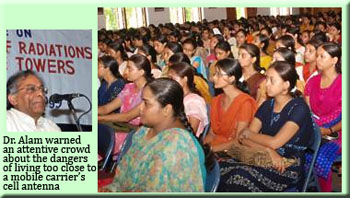 but in India where tower speculators and carriers quickly deployed tens of thousands of sites, they are more lenient, causing residents to be concerned about radio frequency health problems. but in India where tower speculators and carriers quickly deployed tens of thousands of sites, they are more lenient, causing residents to be concerned about radio frequency health problems.
Antennas were placed on many property owners' rooftops without regard to RF emissions. In some extreme cases, an antenna was placed less than ten feet away from where children were sleeping.
Dr. Manzoor Alam, an expert in the health care field and a recipient of the 1995 Charter Mark award, at a program at Patna Women's College in India yesterday, warned the people of the ill-effects of mobile towers in their neighborhood saying if not checked, it could produce massive health problems in the future.
 "These towers are very harmful to humans because they emit dangerous electromagnetic radiation affecting those who are within the range of 100 meters," Dr. Alam said. "These towers are very harmful to humans because they emit dangerous electromagnetic radiation affecting those who are within the range of 100 meters," Dr. Alam said.
If exposed to such radiation for a prolonged period of time, complications like genetic mutation, complicated pregnancy, sleep disorders, headaches, cancer and even brain tumor could occur, he said.
Expressing his concerns over mushrooming cell phone towers on the rooftops across the nation, Dr. Alam suggested a safe zone of 15 meters around mobile towers while also appealing to the mobile companies to adhere strictly to all guidelines for the installation of towers in populated areas.
Fifth on the list of good sites, Indian Hill could get five monopoles
August 11, 2009
PRESCOTT, AZ - The Prescott City Council voted 6-1 Tuesday to approve amended agreements with Sprint and AT&T, an agreement that will allow for future construction of five monopoles on Indian Hill.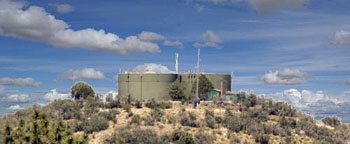
The current agreement provided for the companies to have their antennas attached to the existing Indian Hill water tank that will be replaced.
Prescott Community Development Director Tom Guice told attendees that their was not a need for a special use permit, as requested by some residents, citing the Wireless Communications Plan for Central Arizona, on which Prescott and neighboring communities collaborated in 1998.
"Indian Hill is number five on that list," Guice said.
Under the reasons for the ranking, the plan states that Indian Hill has "good 360-degree coverage," and is "above a residential area, not in it," Guice said.
Zoning board says sprint must take down school's cell phone tower
August 1, 2009
CINCINNATI, OH - A controversial cell phone tower will likely come down in West Price Hill after a zoning board decision. zoning board decision.
The tower was erected in 2008 on a temporary basis, and officials denied a request last week by Sprint to permanently keep the structure near Carson Elementary.
Sprint has 30 days to appeal the decision to City Council.
Cincinnati Public Schools allowed the cell phone carrier to place a temporary, 60-foot tower on the school's roof in 2002, and Sprint erected a new, 90-foot tower there after a new school was built last year.
School officials told zoning examiners that the tower could not be placed on the roof of the new building because the structure wasn't designed to accommodate one.
The original tower had been permitted after zoning officials agreed to make an exception to the zoning code, but no permission had been sought for the new tower.
Zoning officials said the new tower was built too close to nearby homes, and they said efforts to camouflage the tower as a flagpole would be insufficient.
|
|
To capture the ultimate crown in zoning approval,
try permitting this nine-mile-high multi-use cell tower
July 12, 2009
Protracted zoning hearings can last as much as two years or more for a 90-foot mountain top tower that neighbors believe will spoil the area's pristine view.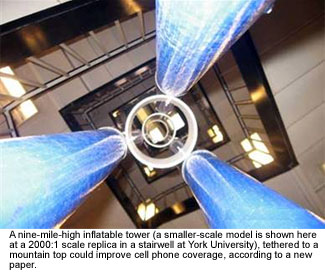
So, pity the poor site acquisition and zoning specialist tasked with permitting one 545 times higher.
An inflatable tower over nine miles tall and tethered to a mountain top could cut the cost to launch spacecraft, reduce the need for geostationary communications satellites and improve cell phone signals, said Brendan Quine, who, along with Raj Seth and George Zhu at York University in Toronto wrote an article detailing their tower in the journal Acta Astronautica.
They say the structure could be made of commercially available materials, and since it wouldn't have to rely upon previous tall tower proposals based upon as-yet to be developed material based on carbon nanotubes, it could be completed by 2020, the designers say.
The Kevlar-laminate tower would be 9.3 miles tall, 754 feet across, and weigh approximately 800,000 tons, or about 1,600 times the weight of the beefy 1,000-foot Stainless LLC guyed tower recently erected in Miami for ABC Channel 10.
For communities that require a 110% setback, the tower owner would have to make sure that there are no homeowners or businesses within a 10.23-mile radius.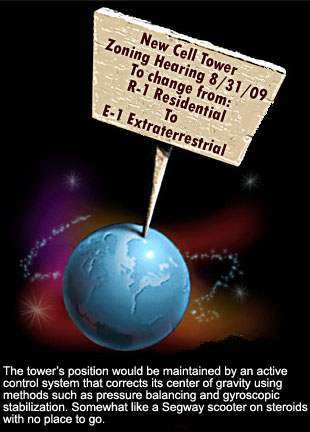
Tower techs working on the top of the structure, according to the York University designers, would be able to ride an elevator that would take about 40 minutes moving at 22 miles per hour.
The tower must be anchored to a mountain 3.1 miles high, therefore, the FCC registration would show an elevation above mean sea level at 12.4 miles.
Tower erectors wouldn't have to worry about fabricating the world's largest gin pole. Their design is a system of nesting segments that roll out vertically and snap into position, much like a telescoping wand. You're not constructing externally, but rather, from internally.
And greasing or installing guyed wires wouldn't be required in your bid. The structure's position would be maintained by an active control system that corrects its center of gravity using methods such as pressure balancing and gyroscopic stabilization.
The system would also counter the forces of nature, says Quine. "During high wind conditions, the structure will need to lean into the wind in order to cancel out external forces," he says.
The team has filed for international patent protection for their design, in partnership with space technology company, Thoth Technology Inc., so don't expect to see a separate, tall, tall, tall tower division at Rohn, Valmont, Sabre or Structural Components anytime soon.
The inflatable tower would be filled with a variety of gases, including helium; requiring tower foundation design engineers to be more concerned about uplift than compressive loads.
A tower technician, or communications array, could see 373 miles in any direction from 12.4 miles in the air.
For tower companies that are concerned about reaching capacity too soon after the tower is built and becoming burdened with heavy retrofitting costs to increase the size of the structure, they need not worry.
The ultimate height of the inflatable tower could be 124 miles, say Quine, Seth and Zhu - a distance that would probably involve pleasing zoning officials and residents in at least 50 or more communities.
|
|
Tenth Supreme Court Justice finds Ninth and Eighth Circuits correctly interpreted telecom law in local government victories
UPDATE: June 29, 2009
The U.S. Supreme Court denied certiorari in both cases today. It is unknown how much influence the Solicitor General's brief played in the Justices' decision.
June 22, 2009
WASHINGTON, DC - In response to a U.S. Supreme Court invitation, the United States Solicitor General has filed a brief (here) expressing the federal government's view that the Eighth Circuit and Ninth Circuit correctly interpreted 47 U.S.C. Sec 253(a) of the Telecommunications Act of 1996 in their 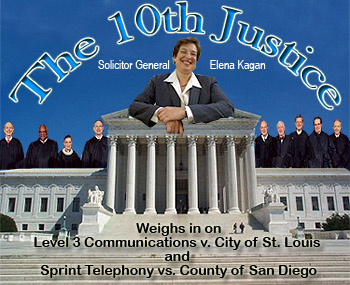 rulings in favor of local governments. rulings in favor of local governments.
The cases, Level 3 Communications v. City of St. Louis, and Sprint Telephony vs. County of San Diego, address local government controls and the reach of telecom ordinances. The St. Louis case deals with wireline issues, while San Diego covered wireless issues.
The Solicitor General said it found that there is no conflict among the courts of appeals that warrants the Supreme Court's intervention at this time. The Supreme Court is expected to decide whether it will take the cases in June.
However, when the Solicitor General's office denies a petition for certiorari, review is frequently not granted.
The Solicitor General, who has offices in the Supreme Court Building as well as the Department of Justice Headquarters, has been called the "10th justice" due to the relationship of mutual respect that develops between the justices and the Solicitor General.
President Obama appointed Elena Kagan as the U.S. Solicitor General in March 2009. This review was one of the first invitations provided by the Supreme Court.
|
|
After building eleven towers without authorization,
Wyoming county cracks down on wireless telco
June 19, 2009
NATRONA COUNTY, WY - Union Telephone will file conditional-use permit applications for at least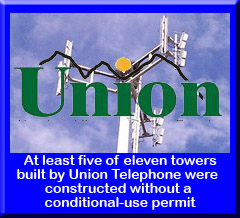 five telecommunications towers illegally erected in Natrona County, the county's development department director said Friday. five telecommunications towers illegally erected in Natrona County, the county's development department director said Friday.
"They want to do what we're requiring," Blair Leist said.
Leist met with representatives of the Mountain View-based Union Telephone the day after he told Natrona County commissioners his department had identified 11 towers that the company had set up without proper authorization.
Today's meeting was cordial, and Leist said the Union Telephone representatives agreed to file the permit applications again -- at twice the cost.
The county could not look away and do nothing, he said. "If Union Telephone did not receive some kind of penalty, other (telecommunications) providers would see Natrona County as an opportunity to come in and put up towers without a penalty," according to a report in the Star Tribune.
Leist took action shortly after a property owner near Alcova sent him a photo showing an approximately 80-foot-tall tower erected on a ridge close to his residence, he said.
|
|
Washington Monument cell tower replica to move to new Mississippi location
June 17, 2009
RIDGELAND, MISSISSIPPI - The cell phone tower that is a miniature replica of the Washington Monument will have to make way for planned frontage roads along Interstate-55.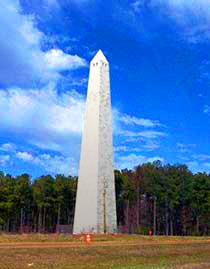
The replica monument that serves as a cell phone tower will have to be moved with officials requesting the construction of a temporary cell phone tower to ensure cell phone reception.
Mississippi Department of Transportation officials are moving forward with plans to construct frontage roads on both sides of I-55 from Old Agency Road in Ridgeland to Madison Avenue in Madison.
The current cell phone tower, built to one-third size, is owned by H.C. Bailey Companies, and is located within the project's right-of-way on the west side of I-55 near Highland Colony Parkway.
H.C. Bailey Co. president H.C. "Buster" Bailey said that the tower will only be moved 400 to 500 feet from where it is now.
Bailey said that the cell tower was originally constructed to be in design with the concept of Colony Park, the mixed used development located along Highland Colony Parkway.
|
|
Feds eye Acadia mountaintop for 80-foot tower
June 5, 2009
ACADIA NATIONAL PARK, MAINE - The top of Acadia National Park's Cadillac Mountain is one of dozens of sites under consideration for an 80-foot tower designed to enhance federal homeland security communications.
A Customs and Border Protection agency spokesman told the Bangor Daily News that Cadillac is one of about 66 locations in Maine that are being eyed for towers to provide agents with better communications capabilities.
He said no decisions have been made and that additional information will be available when the agency's environmental impact statement is submitted.
John Kelly, Acadia's park planner, said there are concerns about the visual impact of another tower on top of Acadia's best-known peak. Cadillac Mountain is the only peak accessible by public road in the park, which gets more than 2 million visitors each year.
There already are two communications towers on top of Cadillac: one used by federal agencies, and another by state and local agencies.
|
|
Residents persuade Crown to cancel 60-foot mono-palm applications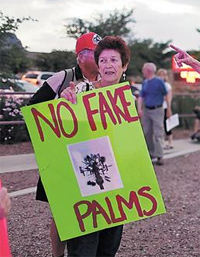
June 4, 2009
MARANA, AZ - Crown Communications withdrew its permit application hours before a Marana Town Council meeting Tuesday at which the council was to discuss whether to authorize a permit for a tower at West Twin Peaks Road and North Coachline Boulevard.
Almost fourty Continental Ranch homeowners staged a protest and press conference last week near the proposed tower location to drum up opposition to building it there.
They hoped that raising awareness would encourage people to speak against it at Tuesday's council meeting.
"The applicant recognized the neighbors were not supportive and felt it wasn't worth trying to push it through at this time," Kevin Kish, town planning director, said in a press report.
Verizon set to build 10 new towers within months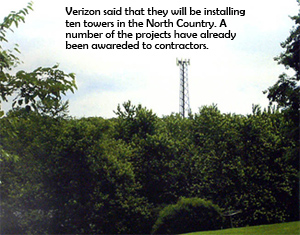
June 1, 2009
LAKE PLACID, NY - Verizon Wireless plans to install 10 new cell-phone towers in the North Country this summer.
"They will go up throughout the region; we'll have them turned on by the end of the year," Verizon spokesman John O'Malley said Monday.
Not all the towers are inside the Adirondack Park, but O'Malley would not release exact locations.
All of the planned towers are new construction, he said, expanding the company's northern cellular telephone network to 90 towers, 26 of which are in the Adirondack Park.
Church might be looked at as a soft sell, but it could be viewed as a pariah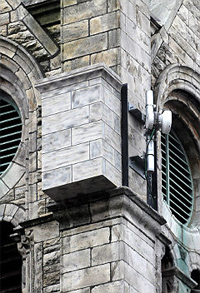
May 31, 2009
SPRING VALLEY, CA - With the explosion of wireless technology, and its increased demand for cell towers, churches are often a soft sell for phone companies offering lease revenue in exchange for hiding their towers on rooftops, steeples or crosses.
Ken Schmidt, president of Steel in the Air, a consulting firm that handles cell tower lease issues, said that opposition from neighborhood opponents can be difficult.
"A church can find itself being in the position of being a pariah in their neighborhood," he said. "That is the biggest drawback I see."
Schmidt said that as the industry is trying to expand into residential areas churches offer two advantages: They are often allowed to violate height restrictions such as placement of a church steeple and they can have smaller decision-making bodies which can simplify lease negotiation.
• • • more
FAA may be concerned about cell tower in the sky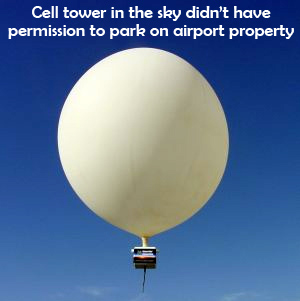
May 30, 2009
MESA, AZ - Airport officials received a number of calls from Mesa residents during the early morning hours about a UFO over the airport as they witnessed a large balloon with blinking lights descend from the dark sky. Friday the airport was still in possession of the object.
"The airport is concerned, and we're forwarding our incident report to the FAA to address that concern," said Brian Sexton, spokesman for the airport, regarding the incident that was first reported at 6:28 a.m.
The UFO turned out to be what is being described as a cell tower in the sky.
Space Data Corp. Chairman and CEO Jerry Knoblach said the individual units usually hover for about 24 hours at an altitude of 80,000 feet before they make their parachute-controlled descent back to earth.
"Space Data operates a wireless network that marries weather balloon technology and the cell tower," he said of the picnic-basket-sized communication devices. "It's basically a cell tower in the sky, and the entire state of Arizona could be covered by one of them."
Sexton said his issue was one of concern for safety involving the parachute dropping in the middle of a busy airport.
Knoblach said the airport was a glitch and his company launches countless SkySites with little to no concern in the aviation community.
|
|
Old Faithful cell site to be moved under new wireless plan
April 21, 2009
WYOMING - Yellowstone National Park has promised to move a cell phone tower overlooking the Old Faithful geyser, but would accept applications for a new cell 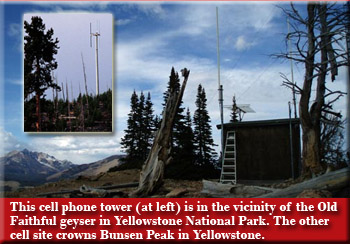 tower near the community of Lake under its wireless communications plan unveiled yesterday. tower near the community of Lake under its wireless communications plan unveiled yesterday.
"We heard from visitors and we worked to be responsive in our final plan," said Al Nash, the park's chief of public affairs.
Park watchdog groups were mixed in their response.
Jeff Ruch, of Public Employees for Environmental Responsibility, said changes to the original proposal were only minor. Tim Stevens of the National Parks Conservation Association said overall the plan protects the park and ensures visitor safety, but the group isn't happy that a cell tower could be constructed at Lake Village.
As part of the wireless plan, park concessions would be allowed to offer Wi-Fi service in some buildings. In response to comments, Wi-Fi will be prohibited in the Old Faithful Inn and the Lake Hotel in order to preserve the historic lodging experience. Concession operators will be permitted to offer Wi-Fi service in other park lodging and general stores.
|
|
Collapse halts New Jersey cell tower zoning meeting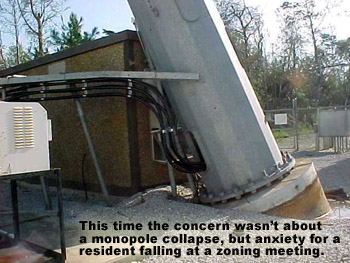
March 27, 2009
FREEHOLD TOWNSHIP, NJ - There have been times when a heated fall radius discussion will tend to draw out comments in a contentious zoning meeting for a cell tower and require a second hearing.
A collapse was a concern of the Freehold Township zoning board while they were conducting a public hearing on Omnipoint Communications' application to install a 120-foot tall monopole on property at 169 Robertsville Road, but it was a human kind.
"No. No. No. You're ruining our quiet, peaceful neighborhood. We don't want your cell tower. Our homes mean something to us," a passionate resident said, and then she fell to the floor.
First aid squad members and paramedics were called to the scene to assist the 81-year-old woman. She later said she had high blood pressure and diabetes.
The woman refused to go to the hospital and went home with her son.
The meeting was halted for the night and will be continued on April 23.
The plan for the T-Mobile monopole requires a variance because a cell tower is not a permitted use in the residential zone.
.
|
 New Hampshire residents enlisting New Hampshire residents enlisting
The Lord's help to defeat church cell site
March 20, 2009
NORTH ANDOVER, NH - The sign in front of an Elm Street home reads, "LORD PLEASE HELP US."
Down the road, another sign says, "My bedroom is right up there. PLEASE don't put a tower across from where I sleep!! Madison Age 8."
Residents are waging a visible fight against Trinitarian Congregational Church, which plans to install a cell phone antenna in its steeple at 72 Elm St.
"What we want is the Lord to hear us and we want the church to hear us," said an Elm Street homeowner.
"We don't know what long-term radiation is going to do."
• • • more |
|
Minnesota mayor demeans the beauty of a seamless coverage tower by calling it a "junkyard on a 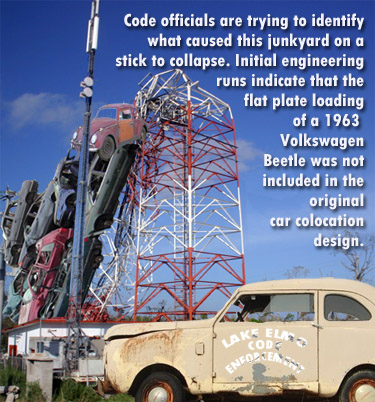 stick" stick"
UPDATE: February 5, 2009 - The Lake Elmo City council voted 3-2 Tuesday night to deny
T-Mobile's request to build a communications tower south of Lake Jane.
T-Mobile representatives said they were disappointed by the denial, but they intend to continue working with the city to find a way to improve their service in the area while addressing the concerns of local residents.
February 2, 2009
LAKE ELMO, MN - Although press reports indicate that Lake Elmo Mayor Dean Johnston may vote for the approval of a 125-foot T-Mobile cell tower inside Sunfish Lake Park tomorrow, he helped to further inflame Lake Elmo's fired up residents opposing the structure by calling it a "junkyard on a stick".
The federal Telecommunications Act of 1996 requires local governments to consider applications for cell towers in a representative amount of time and prohibits them from denying those applications unless they have a legally sound reason.
Because a governing official feels that the tower looks like a vertical salvage yard on steroids is not reason enough to deny it unless an ordinances addresses concealment or other aesthetic requirements.
Oftentimes, applicants are amenable to work with communities to make the structure visually appealing which would include promising not to use 1964 Corvairs, claw foot bathtubs, signed and numbered post modernist artwork and other junkyard materials that are typically used for sector frame mounts for antennas.
Last week, the council decided to have an outside consultant, the Center for Municipal Solutions, review T-Mobile's application and assess whether the proposed height is needed.
|
|
Cell tower at Trixi's saloon draws fire from residents
February 4, 2009
OVANDO, MT - The country's economic stimulus plan has $1 billion set aside for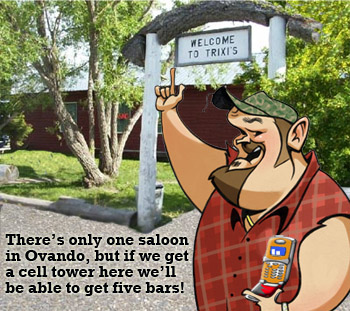 wireless phone services for communities that are either underserved or not served, but a definition hasn't been provided yet to identify those communities. wireless phone services for communities that are either underserved or not served, but a definition hasn't been provided yet to identify those communities.
Ovando, Mt. might be the textbook example for both.
It's a small community of less than 80 residents off of Highway 200 with the Swan and Garnet mountains tumbling to its edges.
Hundreds of thousands of acres of open ranch country surround the area that seems to be frozen in time. And when a rancher wants to quench his thirst, the first and only stop is Trixi's Antler Saloon, named after the former trick rider, roper and show girl who bought it in the 1950's.
But cell service is spotty, if not non existent and Trixi's wants to lasso a contract to place a cell tower outside.
However, the Powell County planning board has the proposal on hold until later this month when they'll hear from Clearview Towers' attorney, Michael Strand.
A number of residents believe that Clearview's Trixi's Antler Saloon's location is too visible. With all of the open land, it is still difficult to find sites that are not under conservation easements.
|
|
Safety rears its head as Verizon tries to temper concerns
January 28, 2009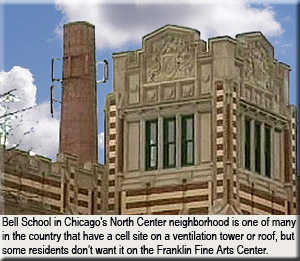
CHICAGO, IL - Some parents are concerned that a cell site at the Franklin Fine Arts Center will affect their children and believe that the risk is not worth the $24,000 per year Verizon Wireless will compensate the school.
At a meeting this week, a Columbia University biophysicist said that people don't feel the radiation and think it's not doing anything, but he said that it's a very potent biological agent and it is best if the community minimizes its exposure to it.
However, Verizon representatives and other experts say their research shows risks are questionable.
"There is no evidence at this current time from animal data that there is a cancer risk associated with cell phone magnetic fields," said Dr. David McCormick, a professor at the Illinois Institute of Technology in a news report.
Franklin's local school council approved the cell tower two years ago, but the project has remained stalled until now.
|
|
Five suits filed in Virginia to overturn board's decision against monopines
January 24, 2009
JAMES CITY, VA - Typically a tower development firm or a carrier will file one suit if they are in 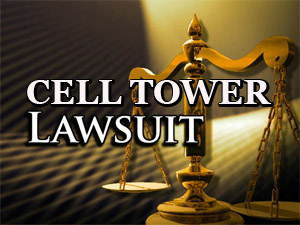 disagreement with a zoning or planning board's decision, but an unprecedented number of suits have been filed this week against the county's Board of Zoning Appeals over its decision to disapprove the structures. disagreement with a zoning or planning board's decision, but an unprecedented number of suits have been filed this week against the county's Board of Zoning Appeals over its decision to disapprove the structures.
Five parties - including two cell phone companies and James City County - want to be heard in court, according to suits filed Tuesday over two disputed cell phone towers proposed for the Kingsmill subdivision.
Suits were filed by Busch Properties, which owns the land where the towers would be built; cell carriers Verizon Wireless and AT&T, which would build the towers; and the Kingsmill Community Services Association, a group of neighborhood residents who favor the towers.
The suits assert that the Board of Zoning Appeals erred when it overturned three previous decisions to allow two 120-foot monopines to be built.
The suits call the board's decision "deeply flawed" and say the board "failed to make any factual findings and conclusions, as required by state and federal law," to overturn the previous decisions.
|
|
Tree gets the ax, but windmill turns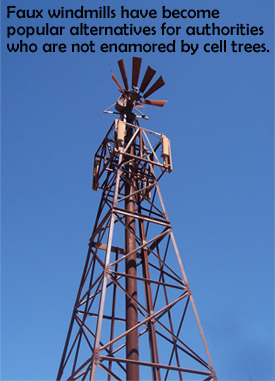 commissioners to approval commissioners to approval
January 2, 2009
A 100-foot tall windmill proved to be more aesthetically appealing to Clark County, NV commissioners than a faux tree to cloak a cell site and they approved it for construction on the north side of Lone Mountain Road and the east side of the Las Vegas Beltway.
Strategic Real Estate Services agreed that the design should have a rustic farmscape windmill appearance in lieu of something more intrusive.
The windmill blades will rise above the array, which sits 80 feet above the ground.
The tower is being built for Verizon, but will have room to add other carriers. It will serve customers within a two- to three-mile radius of the site.
Logandale-Dorrell LLC owns the five acres of land where the tower will be built. The land is intended to be a rural neighborhood preservation area.
|
|
Newest wrinkle in moving administrators is by threatening to pull children out December 16, 2008
MARSHALLTOWN, IA - Although six weeks ago the Marshalltown Community School District Board of Education approved a cell site at the high school football field, community members addressed the board yesterday in hopes of a reversal of the decision. board yesterday in hopes of a reversal of the decision.
One area resident asked the board why they would "take this chance with the lives of children."
She also appealed to their budget needs by inferring that some parents might have their children open enroll out if the structure is built, which is about $5,000 per student yearly.
The money the district would get from U.S. Cellular, $2,000 per month, might not make up for the loss of money if enough students open enroll elsewhere.
As a result the board decided they may want to revisit the issue in the future as the lease has yet to be signed.
The cell phone tower to be put inside a light pole at the football field has already had approval by the city's Plan & Zoning Commission and the Board of Adjustment.
|
|
Residents, cities, county and state synchronized against defeating swim
club monopole application
December 2, 2008
CRANFORD, NJ - After a year of nine meetings on a contentious application to construct a cellular tower at the Cranford Swim Club, the public will still have to wait for a decision on a 120-foot monopole to be erected at the rear of the swim club property on the border of Cranford and Westfield.
According to attorney Greg Meese and other experts for the cellular providers, the tower is necessary to fill a gap in coverage and to meet service demands.
Residents in both communities have objected, saying they do not experience a lack of cellular coverage and that the tower will negatively impact their property values. The application has also drawn objections from Union County and the state.
• • • more
|
|
Governing bodies seeing towers in a new shade of green
November 18, 2008
SAN JACINTO, CA - With the country's threatened and overburdened economy, cell tower leases are starting to look more palatable to city governments as they seek funding to maintain basic services.
Such is the case in San Jacinto at the Luz del Sol 5-acre park where the housing slump doesn't generate enough landscape maintenance fees to pay for the park's upkeep.
That turned into a challenge for Assistant City Manager Tim Hults. But Hults found a solution that will keep the park green and will open the soccer field to use -- a solution other Inland agencies have been using for years to generate thousands of dollars.
• • • more
|
Last of 14 towers awarded to St. Louis Park firm
November 7, 2008
WASHINGTON COUNTY, MN - The Washington County Board of Commissioners voted unanimously to approve a contracting bid for the construction of the last of 14 radio towers in Washington County that will allow the county to get its 800-megahertz radio system online by early next year.
The county voted to approve a contract bid with Omni Contracting Inc. of St. Louis Park to perform construction services of the 88-foot "stealth tower" that is designed to esemble a pine tree.
Earlier this month, the county board voted to approve a contract with Sabre Towers and Poles Inc. of Sioux City, Iowa, to construct the monopole that city of Afton officials said they would prefer because the tower would blend in with the rural scenery. |
Mayor nixes residents' requests to block Idaho tower
November 5, 2008
GRANGEVILLE, ID - Some residents in the northern Idaho town of Grangeville say a 200-foot cell tower being built in town is a health hazard and have asked the city council to prevent its construction.
But Mayor Bruce Walker says he doubts the city can do anything because the tower is located in an industrial zone.
He also says residents weren't notified that the tower would be built because there's no legal requirement to do so when a project involves only a standard building permit.
Resident Mathew Smith says the tower being built by Verizon Communications Inc. is too close to private homes, two elderly care centers, and a hospital. |
 |
|
|